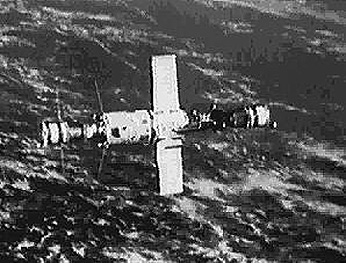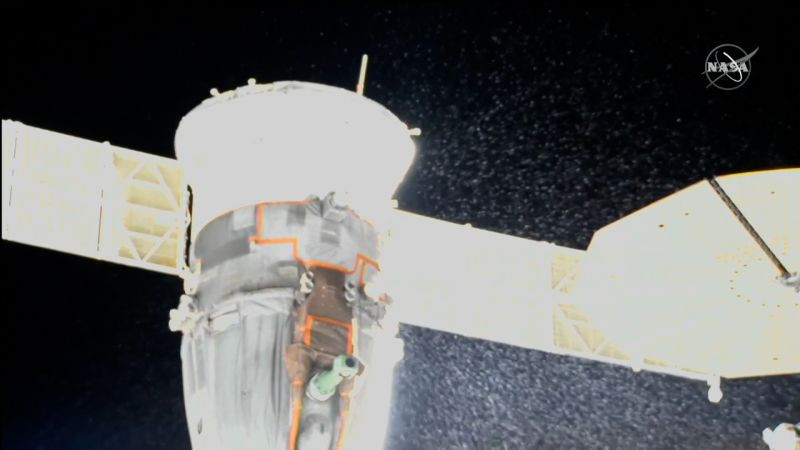Though oddly beautiful in its own way, it’s a sight no astronaut wants to see: their spacecraft, the only way they have to return to Earth, ejecting countless iridescent droplets of something into space.
When the crew of Apollo 13 saw their craft literally bleeding out on their trip to the Moon it was clear the mission, and ultimately their lives, were in real jeopardy. Luckily the current situation is not nearly as dire, as the leaking Soyuz MS-22 spacecraft docked to the International Space Station doesn’t pose any immediate danger to those aboard the orbiting laboratory. But it’s still an unprecedented situation, and getting its crew home will require engineers on the ground to make some very difficult decisions.
This situation is still developing, and neither NASA nor their Russian counterpart Roscosmos have released much in the way of specifics. But we can make some educated guesses from the video and images we’ve seen of the stricken Soyuz capsule, and from what’s been shown to the public so far, things aren’t looking good.
Running on Empty
On Wednesday the 14th, just as Russian cosmonauts Sergey Prokopyev and Dmitriy Petelin were preparing to begin a scheduled extravehicular activity (EVA) that would have taken them outside of the Station, an alert went off indicating that coolant levels in the docked Soyuz MS-22 capsule were dropping. Upon panning external cameras over to the spacecraft, it was immediately clear this was no false alarm — as liquid could been seen spewing out of the rear of the vehicle.
As illustrated in the diagram above, the Soyuz pumps coolant through a pair of heat exhangers located in the Orbital Module (left) and Descent Module (center), which ultimately makes its way to several external radiators mounted on outside of the Service Module (right). The coolant lines that connect these modules actually run along the outside of the craft’s hull, though they are obscured from view by the thermal blankets that cover most of the vehicle’s exterior.
While the exact cause of the leak is not yet known, the current theory is that a micrometeoroid or other piece of small space debris hit either the radiators or one of the external cooling lines. The hope was that closer examination over the weekend might help determine the cause of the leak, but in any event, the result is the same. With no way to stem the flow, it’s believed that all of the system’s coolant was dumped overboard during the event, leaving the system inoperable.
The system is responsible for not only keeping the inside of the Descent Module at a comfortable temperature for its human occupants, but for cooling the flight computers and other equipment buried deep within the craft. Trying to repair and refill the cooling system while in orbit would be exceptionally difficult, and is almost certainly going to be deemed too risky to even attempt. So the question Russian engineers must now answer is whether or not the Soyuz can safely bring its crew of three back to Earth with its cooling system offline.
Remote Rescue
At the time of this writing, no official announcement has been made, but many space pundits are of the opinion that safest approach is to assume the Soyuz MS-22 is no longer flightworthy. While a system test performed after the leak was discovered showed that the vehicle appeared to be operating normally, and its thrusters were still functional, the possibility of the computer overheating and shutting down during flight presents an unacceptable risk to the crew. The reentry procedure can be performed manually if absolutely necessary, but it’s likely the capsule would land outside of the designated coordinates, complicating recovery operations.

Of course, that assumes the cooling system is the only thing damaged. If the craft was struck with a piece of space debris, there’s no telling what other systems could have been impacted without a thorough examination — something that may difficult to do from an EVA.
If Roscosmos determines that Soyuz MS-22 is no longer fit for purpose, they will likely decide to fly the next Soyuz to the ISS remotely so it can replace the damaged vehicle. If possible, they may even push up the currently scheduled March 2023 launch date.
While exceedingly rare, such a situation isn’t without precedent. In April 1979, when the viability of their Soyuz capsule came into question, the crew of the Soviet Salyut 6 station had to wait on a fresh spacecraft to bring them home. In the end, both the vehicles made it back to Earth safely, but that doesn’t mean it wasn’t worth the additional time and expense to make sure the crew had the best chance of survival.
Not Enough Lifeboats
But there’s a problem with this plan. If it’s determined that the Soyuz MS-22 is no longer safe for human occupants and needs to be replaced, it will mean that for the first time in its history, there won’t be enough spacecraft docked to the International Space Station to bring all of the crew members home in the event of an emergency.
In the unlikely event that the ISS suffers some catastrophic failure before a new Soyuz can be sent up, Sergey Prokopyev and Dmitry Petelin, as well as American astronaut Francisco Rubio, won’t have a safe way off the Station. As a matter of necessity they would likely be instructed to board the semi-functional Soyuz MS-22 and prepare to undock should they need to evacuate, but what happens after that in this nightmare scenario is anyone’s guess. Hopefully, we won’t have to find out.

















A space Titanic.
I’m not entirely sure that’s fair, I mean yes currently it’s short lifeboats and yes there is absolutely no margin for error but on the flip side, the titanic was *designed* with insufficient lifeboats and the ISS wasn’t. And one could argue they should have a spare, but if that spare sits up there long enough it seems likely that it might get damaged too, or perhaps worse yet, have an unknown readiness for being used because it wasn’t designed to just hang out in space for years at a time.
It’s more specific than that: Soyuz has a fairly limited on-orbit lifespan, iirc due to hydrogen peroxide decomposing that is used for something. They can’t just leave one there, which is why they’re continually rotating them thru. I thought some time ago they were leaving a spare on orbit but continually swapped out (crew going up in N would return in N-1) but that is presumably no longer the case.
Competence rot
Somebody call Mattel. They can be anything or maybe Legos
https://patentscope.wipo.int/search/en/detail.jsf?docId=WO2022264177&_cid=P22-LBYWS8-05338-1
Icebergs in space??
Better be a space Titanic than flying Barbecue Brick…
A revenge for Mariupol? All it takes is a single ruZZian engineer disillusioned with putler’s lies. A loose screw or metal shaving in the right spot and families of orc astronauts will be getting a new Lada for xmas 😉
The preceding message was brought to you by The Counterfeit Posing as Ren
Zelensky is that you? Just another bot.
It’s simple. SpaceX will send theirs to rescue everyone.
they probably stand a better chance holding they breath
watch Don’t Look Up
The three extras can climb into the cargo area of the crew dragon and hold on tight.
funny you should say that, dragon was going to hold and has room for that many more seats.
But nasa for some reason didn’t want risk that many crew.
Which as we can tell now after so many safe launches, is not a concern.
Wouldn’t it be slightly ironic if it turns out this was a piece of debris from Russia’s anti-satellite missile test, late last year?
If it’s a Russian investigation of the loadout turn out, it was the Ukrainians bombing their own space craft.
Urgh, random dictation words. Sorry!
There’s an American up there too. Don’t be a ghoul.
Then we need to send a SpaceX ship ASAP.
The problem is not how they can launch a rescue ship, but WHEN.
Rocket don’t pop out of a hat, launch window too.
There are heroic humans up there with families down here. Who cares where they get their mail sent.
Most relevant comment here.
Oh I’m right there with you, I just have an obligation to point out people who have spent the last year cackling with glee over dead sons and fathers
Those are all human beings up thare…..
Get a new spacecraft up there ASAP and fly the damaged Soyuz back to Earth remotely for a full investigation and repair. The Russians are unlikely to share all of the information they find but at least all of the crew will be kept safe.
The service module doesn’t return so a complete investigation can’t really be done.
The problem is the next Soyuz won’t be ready until February, and the next Dragon flight is also scheduled for then, and it’s unclear how quickly it can be made ready for flight.
Theoretically China’s Shenzhou can dock with the ISS, but I don’t see that happening.
It would be a win for nationalism and face. China, the country that can do what two superpowers could not.
provided they use compatible docking rings.
Would this be possible to have all three return to Earth?
Все, что угодно, чтобы избежать сквозняка
Where is Elon Musk with the flying dragon?
Or Bezos with his flying “adult toy”. Oh, right, I forgot it can’t dock with the ISS, shame, that function would have come in handy.
Well, you chose to give all the sweet subsidy money and government deals to Mr. Twitter instead, so you can’t blame the others for not having built the stuff out of nothing.
My friend Jeff Bezos&blue Origin got more funding(4.8B$) than SpaceX(3.1B$) and still managed to fail even their most basic tasks, while taking longer to deliver a functioning prototype.
Except, isn’t Bezo’s company Blue Origin, which, if you check their Wikipedia page, has a huge list of government contracts and funding too.
As much as I dislike Musk as a person, SpaceX has not been show favoritism by the government when compared to other space companies like Boeing, Aerojet Rocketdyne, etc.
Boeing and aerojet are aerospace companies, SpaceX is a rocket company, big difference
Honestly who cares, let the Ruski’s hitch a ride on Elon’s Crew Dragon. What’s the problem?
Capacity. Crew Dragon was originally intended to carry up to 7, but I think it’s only rated to 4. (Also pretty sure the seats are custom for each astronaut)
If they had a spare Crew Dragon that could probably fly up as lifeboat as easily as a spare Soyuz (seats notwithstanding) but I suspect it would be politically much more touchy than a Soyuz saving a Soyuz.
That Soyuz brought up two Russians and an American, btw.
Soyuz or Crew Dragon, when human lives are involved, politics be damned.
Like how Russia is so concerned for Ukrainian human lives?
Keep all aboard in your prayers… these are human beings we’re talking about with families
Thank you!
Clearly a rusian spy
Best comment.
I guess I don’t understand why a Dragon or, literally any other spaceworthy craft, isn’t sent up to keep station as a lifeboat in case of the unthinkable. Even IF it can’t bring them home, having a functional craft able to disembark them in the event of catastrophic failure of the station seems preferable to trying to use a damaged craft.
This Soyuz is the lifeboat kept at the station.
The current policy is to always have enough capacity at the ISS to evacuate it if required.
There’s not enough docking ports on the US side to keep a spare Dragon as well as the non-spare Dragon and a cargo craft.
I think there’s room for spare Soyuz, but they only have a limited time they can remain in space, and it would mean Russia building a spare spacecraft and sending it up empty when they can barely afford to launch the ones they do.
What is so great about rescue .uS and Russia has cooperated for long after space shuttle episode.
Space station is a shining example of cooperation.
I’m surprised there’s not at least 2 independent loops to prevent one leak disabling the whole system, as is done for aircraft hydraulic systems.
the soyuz is russian,so it will still fly without the cooling
circuit,AND, will land with the auto pilot dead,on full
manual control,which ALL of the crew will be trained on
so its politics,with the realy hard decision between
letting the russians or possibly worse ,ELO,get the
credit for a big save
its just killing them ,a real space drama while they
are promoting the plague war
Always trust Soviet equipment…
Maybe they don’t want to return to this planet. Did anybody even ask them?
I’m sorry, I inadvertently expose myself to daily news and internet commenters too much and feel a little cynical about the planet.